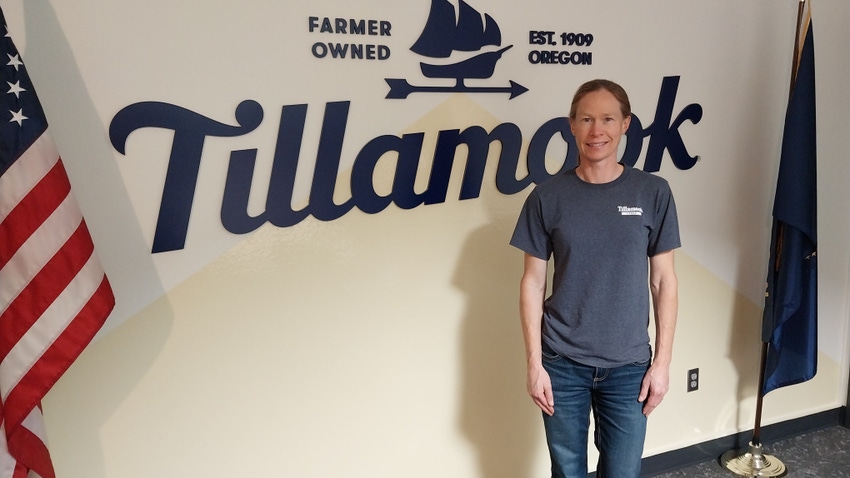
For a dairy cooperative that’s set a goal of reducing its greenhouse gas emissions by 30% over the next six years, achieving buy-in among member farmers would seem to be a major task.
At Oregon’s Tillamook County Creamery Association, that task falls on Kate Lott, the co-op’s six-year director of farm management. But it hasn’t been as difficult as one might expect, considering a culture of sustainability has prevailed among producers in the Tillamook region for generations.
“I think a lot of them think, ‘I don’t do anything,’” Lott told Farm Progress, while noting that a given farmer is putting in new tide gates, reducing methane or sampling soil just as a matter of practice. “He’s doing the things but doesn’t even think about it.”
Perhaps the biggest obstacle for member dairies, she said, is finding the money to do projects.
“The big thing is people come and say, ‘All your farmers should do X,’” Lott said. “We’ve tried to be opportunistic … We get them to choose first. If it’s just a cost burden for them, they aren’t as on board as if they would see a benefit first.”
Three years after gaining status as a Certified B Corporation for its commitment to environmental stewardship and worker-friendly practices, Tillamook has been taking incremental steps in its sustainability journey.
In 2022, the cooperative committed to the dairy industry’s net-zero climate goals for 2050, including achieving greenhouse gas neutrality, optimizing water use efficiency while maximizing recycling, and improving water quality by optimizing use of manure and nutrients.
TCCA’s multi-faceted approach to its climate action plan involves its facilities and fleet, on-farm practices and packaging. For instance, the company wants to convert its fleet of 16 diesel trucks to alternative, low-carbon fuels by 2030 and adopt new technology to improve driving habits that will improve safety and increase miles per gallon.
Four-pronged approach
The effort includes a four-pronged approach on farms, according to the cooperative:
Dairy biodigesters: Digesters use innovative technology to convert manure waste into energy or renewable natural gas, fertilizer, and bedding – a practice many TCCA farmer-owners and milk suppliers are adopting. About 25% of manure in Tillamook County currently goes to a digester or compost facility.
Manure additives: TCCA is piloting an all-natural manure tank additive on farms in Tillamook County that reduces odor and has been shown to reduce methane by 20%. As of late 2022, 20 farms were using the additive in manure tanks.
Enteric emissions: Cows have amazing digestive systems that can convert grass, corn and agricultural by-products into healthy food, but this results in enteric emissions – cow burps. TCCA is tracking innovations in feed additives such as seaweed and other supplements that show potential in reducing enteric emissions.
Regenerative agriculture practices: Cover cropping, low- or no-till, and compost applications reduce GHG emissions while building soil health, enhancing microbial communities, and improving water quality. Nearly all the TCCA farmer-members practice cover cropping and many use both low-till and compost application to feed production areas.
The TCCA is working with other businesses to help achieve its goals. Last year, the cooperative announced a partnership with New Seasons Market, an Oregon retailer, to establish a native riparian forest habitat on coastal farmland.
“This is a land of five rivers going into a bay, so there’s been a lot of work in the county to protect waterways,” Lott said.
A veterinarian and farmer
To shepherd these on-farm efforts, the TCCA has turned to Lott, who grew up on a pear orchard and beef cattle ranch in Parkdale, Ore., where her family continues to farm. A veterinarian, Lott has focused on dairy since doing an internship at a 3,600-cow dairy farm in Michigan, where she later practiced for eight years. She, her husband and two sons later managed an 800-cow dairy in Washington state for a year before moving to Tillamook.
“My mom’s family is from Tillamook, so we ended up here,” she said. She had a mobile vet dairy practice for three years before joining the creamery in 2017. “I had an opportunity to take this job and hopefully provide bigger and better success for (producers).”
Her role at TCCA centers around farm services; providing resources and services to Tillamook member farms and maintaining a comprehensive farm assurance plan to promote improved farming practices, according to a biography on the National Dairy FARM Program website. The program promotes sustainable practices in the industry.
One thing Lott knew going in was that stewardship on Tillamook farms was far from a new concept.
“They did a huge fencing project about 25 years ago … to keep cattle out of waterways,” she said. “Farmers were doing a good job with fencing off waterways, which is a good way to steward water.”
Among the most important tasks at hand is to gather more complete data on the carbon footprint of dairy farms, she said. About half Tillamook’s producers recently opted into a benchmarking program to measure how much carbon their farmland stores, which helps them to accurately measure their overall carbon output.
The surveys were part of a nationwide effort by the FARM Program, which stands for Farmers Assuring Responsible Management. The information could generate funding for sustainability projects and help farmers determine which projects to prioritize.
“I think we’re slowly chipping away,” Lott said. “We’ve got to get baseline data … That’s the big thing. They want to do practices but don’t have the baseline data.
“I think the public is looking for a silver bullet,” she said. “But those of us who do the work realize it’s a long-term commitment… I think farmers are good at that. They’ve done it for generations.”
About the Author(s)
You May Also Like






